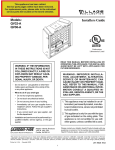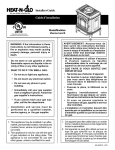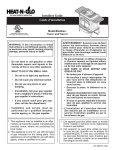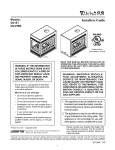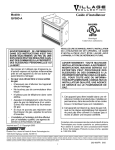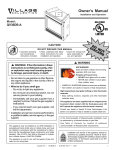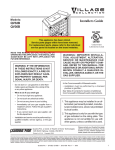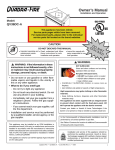Download United States Stove DV12 Specifications
Transcript
Model: Installers Guide BE-41 Underwriters Laboratories Listed READ THIS MANUAL BEFORE INSTALLING OR OPERATING THIS APPLIANCE. THIS INSTALLERS GUIDE MUST BE LEFT WITH APPLIANCE FOR FUTURE REFERENCE. WARNING: IF THE INFORMATION IN THESE INSTRUCTIONS IS NOT FOLLOWED EXACTLY, A FIRE OR EXPLOSION MAY RESULT CAUSING PROPERTY DAMAGE, PERSONAL INJURY, OR DEATH. WARNING: IMPROPER INSTALLATION, ADJUSTMENT, ALTERATION, SERVICE OR MAINTENANCE CAN CAUSE INJURY OR PROPERTY DAMAGE. REFER TO THIS MANUAL. FOR ASSISTANCE OR ADDITIONAL INFORMATION CONSULT A QUALIFIED INSTALLER, SERVICE AGENCY, OR THE GAS SUPPLIER. - Do not store or use gasoline or other flammable vapors and liquids in the vicinity of this or any other appliance. - What to do if you smell gas Do not try to light any appliance. Do not touch any electrical switch. 1. This appliance may be installed in an aftermarket, permanently located, manufactured (mobile) home, where not prohibited by local codes. Do not use any phone in your building. Immediately call your gas supplier from a neighbor's phone. Follow the gas supplier's instructions. If you cannot reach your gas supplier, call the fire department. - Installation and service must be performed by a qualified installer, service agency, or the gas supplier. 2. This appliance is only for use with the type of gas indicated on the rating plate. This appliance is not convertible for use with other gases, unless a certified kit is used. Printed in U.S.A. Copyright 2000, Heat-N-Glo, a division of Hearth Technologies Inc. 20802 Kensington Boulevard, Lakeville, MN 55044 Please contact your Heat-N-Glo dealer for any questions or concerns. For the number of your nearest Heat-N-Glo dealer, please call 952-985-6000. This product is covered by one or more of the following patents: (United States) 4,112,913; 4,408,594; 4,422,426; 4,424,792; 4,520,791; 4,793,322; 4,852,548; 4,875,464; 5,000,162; 5,016,609; 5,076,254 5,191,877; 5,218,953; 5,328,356; 5,429,495; 5,452,708; 5,542,407; 5,613,487; (Australia) 543790; 586383; (Canada) 1,123,296; 1,297,746; 2,195,264; (Mexico) 97-0457; (New Zealand) 200265; or other U.S. and foreign patents pending. 394-900B 9/00 1 SAFETY AND WARNING INFORMATION These units MUST use one of the vent systems described in the Installing the Fireplace section of the Installers Guide. NO OTHER vent systems or components MAY BE USED. ! READ and UNDERSTAND all instructions carefully before starting the installation. FAILURE TO FOLLOW these installation instructions may result in a possible fire hazard and will void the warranty. ! ! Prior to the first firing of the fireplace, READ the Using Your Fireplace section of the Owners Guide. ! This gas fireplace and vent assembly MUST be vented directly to the outside and MUST NEVER be attached to a chimney serving a separate solid fuel burning appliance. Each gas appliance MUST USE a separate vent system. Common vent systems are PROHIBITED. ! INSPECT the external vent cap on a regular basis to make sure that no debris is interfering with the air flow. ! The glass door assembly MUST be in place and sealed, and the trim door assembly MUST be in place on the fireplace before the unit can be placed into safe operation. ! ! ! DO NOT USE this appliance if any part has been under water. Immediately CALL a qualified service technician to inspect the unit and to replace any part of the control system and any gas control which has been under water. THIS UNIT IS NOT FOR USE WITH SOLID FUEL. Installation and repair should be PERFORMED by a qualified service person. The appliance and venting system should be INSPECTED before initial use and at least annually by a professional service person. More frequent cleaning may be required due to excessive lint from carpeting, bedding material, etc. It is IMPERATIVE that the units control compartment, burners, and circulating air passageways BE KEPT CLEAN to provide for adequate combustion and ventilation air. ! Always KEEP the appliance clear and free from combustible materials, gasoline, and other flammable vapors and liquids. ! NEVER OBSTRUCT the flow of combustion and ventilation air. Keep the front of the appliance CLEAR of all obstacles and materials for servicing and proper operations. ! ! ! Due to the high temperature, the appliance should be LOCATED out of traffic areas and away from furniture and draperies. Clothing or flammable material SHOULD NOT BE PLACED on or near the appliance. ! The glass door assembly SHALL ONLY be replaced as a complete unit, as supplied by the gas fireplace manufacturer. NO SUBSTITUTE material may be used. ! DO NOT USE abrasive cleaners on the glass door assembly. DO NOT ATTEMPT to clean the glass door when it is hot. ! ! Children and adults should be ALERTED to the hazards of high surface temperature and should STAY AWAY to avoid burns or clothing ignition. Young children should be CAREFULLY SUPERVISED when they are in the same room as the appliance. 2 DO NOT OPERATE this appliance with the glass door removed, cracked, or broken. Replacement of the glass door should be performed by a licensed or qualified service person. DO NOT strike or slam the glass door. Turn off the gas before servicing this appliance. It is recommended that a qualified service technician perform an appliance check-up at the beginning of each heating season. Any safety screen or guard removed for servicing must be replaced before operating this appliance. TABLE OF CONTENTS Safety and Warning Information ................................................ 2 Service Parts Lists ..................................................................... 4 Section 1: Approvals and Codes ............................................... 6 Approval Listings and Codes ........................................................ 6 Appliance Certification................................................................... 6 Installation Codes .......................................................................... 6 High Altitude Installations ............................................................... 6 Section 2: Getting Started ......................................................... 7 Introducing the Heat-N-Glo Gas Fireplaces .................................. 7 Pre-installation Preparation ........................................................... 7 Section 3: Installing the Fireplace ............................................ 9 Step 1 Locating the Fireplace ................................................... 9 Step 2 Framing the Fireplace.................................................. 10 Step 3 Installing the Vent System ............................................ 12 A. Vent System Approvals ........................................... 12 B. Installing Vent Components .................................... 18 C. Vent Termination .................................................... 21 Step 4 Positioning, Leveling, and Securing the Fireplace................................................. 24 Step 5 The Gas Control Systems ........................................... 24 Step 6 The Gas Supply Line ................................................... 25 Step 7 Gas Pressure Requirements ...................................... 25 Step 8 Wiring the Fireplace .................................................... 26 Step 9 Finishing ...................................................................... 27 Step 10 Installing Trim, Logs, and Ember Material.................... 27 Installing the Trim ......................................................... 27 Positioning the Logs .................................................... 27 Placing the Ember Material .......................................... 30 Step 11 Before Lighting the Fireplace ....................................... 30 Step 12 Lighting the Fireplace .................................................. 30 After the Installation ..................................................................... 30 Section 4: Maintaining and Servicing Your Fireplace ......... 31 3 1 Approvals and Codes Appliance Certification High Altitude Installations The Heat-N-Glo fireplace models discussed in this Installers Guide have been tested to certification standards and listed by the applicable laboratories. U.L. Listed gas fireplaces are tested and approved for elevations from 0 to 2,000 feet in the U.S.A. and from 0 to 4,500 feet in Canada. When installing this fireplace at an elevation above 2,000 feet (in the United States), it may be necessary to decrease the input rating by changing the existing burner orifice to a smaller size. Input should be reduced four percent (4%) for each 1,000 feet above sea level, unless the heating value of the gas has been reduced, in which case this general rule will not apply. To identify the proper orifice size, check with the local gas utility. Certification MODEL: BE-41 LABORATORY: Underwriters Laboratories TYPE: Direct Vent Gas Fireplace Heater STANDARD: ANSI Z21.88CGA2.33 When installing this fireplace at an elevation between 2,000 and 4,500 feet (in Canada), the input rating must be reduced by ten percent (10%). Installation Codes The fireplace installation must conform to local codes. Before installing the fireplace, consult the local building code agency to ensure that you are in compliance with all applicable codes, including permits and inspections. When installing this fireplace at an elevation above 4,500 feet (in Canada), check with local authorities. Consult your local gas utility for assistance in determining the proper orifice for your location. In the absence of local codes, the fireplace installation must conform to the National Fuel Gas Code ANSI Z223.1 (in the United States) or the CAN/CGA-B149 Installation Codes (in Canada). The appliance must be electrically grounded in accordance with local codes or, in the absence of local codes with the National Electric Code ANSI/NFPA No. 70 (in the United States), or to the CSA C22.1 Canadian Electric Code (in Canada). These models may be installed in a bedroom or bed-sitting room in the U.S.A. and Canada. Heat-N-Glo Quality Systems registered by SGS ICS 6 2 Getting Started Introducing the Heat-N-Glo Gas Fireplaces Heat-N-Glo direct vent gas fireplaces are designed to operate with all combustion air siphoned from outside of the building and all exhaust gases expelled to the outside. The vent system components and trim doors are shipped in separate packages. The gas logs may be packaged separately and must be field installed. The information contained in this Installers Guide, unless noted otherwise, applies to all models and gas control systems. Gas fireplace diagrams, including the dimensions, are shown in this section. Read all of the instructions before starting the installation. Follow these instructions carefully during the installation to ensure maximum safety and benefit. Failure to follow these instructions will void the owners warranty and may present a fire hazard. Pre-install Preparation This gas fireplace and its components are tested and safe when installed in accordance with this Installers Guide. Report to your dealer any parts damaged in shipment, particularly the condition of the glass. Do not install any unit with damaged, incomplete, or substitute parts. 7 When planning a fireplace installation, its necessary to determine: Where the unit is to be installed. The vent system configuration to be used. Gas supply piping. Electrical wiring. Framing and finishing details. Whether optional accessoriesdevices such as a fan, wall switch, or remote controlare desired. If the fireplace is to be installed on carpeting or tile, or on any combustible material other than wood flooring, the fireplace should be installed on a metal or wood panel that extends the full width and depth of the fireplace. The Heat-N-Glo Warranty will be voided by, and Heat-N-Glo disclaims any responsibility for, the following actions: Installation of any damaged fireplace or vent system component. Modification of the fireplace or direct vent system. Installation other than as instructed by Heat-N-Glo. Improper positioning of the gas logs or the glass door. Installation and/or use of any component part not manufactured and approved by Heat-N-Glo, not withstanding any independent testing laboratory or other party approval of such component part or accessory. ANY SUCH ACTION MAY POSSIBLY CAUSE A FIRE HAZARD. 28 1/2 [724mm] 14 ¼ [362mm] 21 1/2 [548mm] 8 5/8 [219mm] VENT COLLARS 11 5/8 [297mm] ELECTRICAL ACCESS 8 5/8 [219mm] VENT COLLARS GAS LINE ACCESS 38 [965mm] 25 ¼ [642mm] 34 5/8 [879mm] 2 1/8 [55mm] 3½ [90mm] 24 5/8 [625mm] 36 1/8 [916mm] 10 ¼ [259mm] 41 [1043mm] 6 7/8 [174mm] TOP STANDOFFS TOP VENT COLLARS REAR VENT COLLARS HOOD TOP LOUVER LOWER LOUVER RATING PLATE AND LABELS GAS LINE ACCESS ELECTRICAL ACCESS GAS CONTROLS Figure 1. Diagram of BE-41 8 3 Step 1. Minimum Clearances from the Fireplace to Combustible Materials Inches mm Glass Front ........................ 36 .................... 914 Floor ................................... 0 ....................... 0 Rear ................................... 1/2 ..................... 13 Sides ................................. 1/2 ..................... 13 Top ................................... 3 1/2 ................... 89 Ceiling* .............................. 31 .................... 787 * The clearance to the ceiling is measured from the top of the unit, excluding the standoffs (see Figure 35). Installing the Fireplace Locating the Fireplace The diagram below shows space and clearance requirements for locating a fireplace within a room. The distance from the unit to combustible construction is to be measured from the unit outer wrap surface to the combustible construction, NOT from the screw heads that secure the unit together. Minimum Clearances from the Vent Pipe to Combustible Materials Inches mm Vertical Sections. ............. 1 ................ 25 Horizontal Sections Top ..................................... 3 ................ 75 Bottom ............................... 1 ................ 25 Sides ................................. 1 ................ 25 A 42 Figure 2. B 22 C 36 D 51 At Wall Firestops Top .................................. 2 1/2 ............ 63.7 Bottom .............................. 1/2 ............... 13 Sides ................................. 1 ................ 25 E 72 Fireplace Dimensions, Locations, and Space Requirements For minimum clearances, see the direct vent termination clearance diagrams on pages 22 and 23 in this manual. Clearance Requirements The top, back, and sides of the fireplace are defined by stand-offs. The minimum clearance to a perpendicular wall extending past the face of the fireplace is one inch (25 mm). The back of the fireplace may be recessed 21 1/2 inches (546 mm) into combustible construction. 9 Step 2. Framing the Fireplace CAUTION: MEASURE FIREPLACE DIMENSIONS AND VERIFY FRAMING METHODS AND WALL COVERING DETAILS BEFORE FRAMING. Fireplace framing can be built before or after the fireplace is set in place. Framing should be positioned to accommodate wall coverings and fireplace facing material. The diagram below shows framing reference dimensions. Shows center of 12 x OF12" 12 ventXframing SHOWS CENTER 12" holes for top and rear venting. The center VENT FRAMING HOLES FOR of the hole is one (1) inch (25.4mm) above TOP & REAR VENTING. the center of the horizontal vent pipe. B E C D A 1/2” CLEARANCE FROM BACK OF FIREPLACE TO COMBUSTIBLE A. ............... 42 B. ......... 38 1/2 1/2” CLEARANCE FROM BOTH SIDES OF FIREPLACE TO COMBUSTIBLE C. ............... 22 D. ............... 42 E. ......... 25 5/8 FRAMING MEMBER Framing should be constructed of 2 X 4 lumber or heavier. 0” CLEARANCE Figure 3. Framing Dimensions 10 0” CLEARANCE TO FRAMING MEMBER 6 7/16” (164mm) 8 1/2” (216mm) 8 1/2” (216mm) 7 3/8” (187mm) 11 1/16” (281mm) 5 7/8” (149mm) 8 5/8” (220mm) 6 1/2” (165mm) 5 1/16” (129mm) 8 5/8” (220mm) 11 15/16” (303mm) DV-45D DV-90D DV-36D DV-48D DV17/24D DV-12/17D 17-24 (432-610mm) 35 3/4” (908mm) 47 3/4” (1.2m) 5 3/4” (146mm) DV-09D DV-06D NOTE: PIPES OVERLAP 1-3/8 INCHES (34.93mm) AT EACH JOINT. Figure 4. D-Series Direct Vent Component Specifications (5-inch inner pipe / 8 5/8-inch outer pipe) 11 11 3/4” (298mm) 8 3/4” (222mm) DV-12D Step 3. Installing the Vent System A. Vent System Approvals Identifying Vent Components These models are approved to use D-series direct vent pipe components and terminations (see Figures 4 and 5). Approved vent system components are labeled for identification. This pipe is tested and listed as an approved component of the fireplace. The pipe is tested to be run inside an enclosed wall. There is no requirement for inspection openings at each joint within the wall. There is no required pitch for horizontal vent runs. NO OTHER VENTING SYSTEMS OR COMPONENTS MAY BE USED. The vent systems installed on this gas fireplace may include one, two, or three 90° elbow assemblies. The relationships of vertical rise to horizontal run in vent configurations using 90° elbows MUST BE strictly adhered to. The rise to run relationships are shown in the venting drawings and tables. Refer to the diagrams on the next several pages. NOTE: Two 45° elbows may be used in place of one 90° elbow. Rise to run ratios in the vent system must be followed if 45° elbows are used. Detailed installation instructions are included with each vent termination kit and should be used in conjunction with this Installers Guide. This model has vent starting collars on both the top and the back of the unit. Depending upon the installation, decide which ONE set of starting collars will be used to attach the vent system. The starting collar sealing cap must remain on the starting collar NOT used. The flame and ember appearance may vary based on the type of fuel burned and the venting configuration used. VERTICAL TERMINATION STORM COLLAR ROOF FLASHING HORIZONTAL TERMINATION HORIZONTAL PIPE SUPPORT PIPE LENGTH WALL FIRESTOP Terminations Kits CEILING FIRESTOP 90 DEGREE ELBOW DVK-01D DVK-TVCD DVK-01TRD Figure 5. Vent System Components and Termination Kits 12 WALL BRACKET HORIZONTAL VENTING Kit No. H Max. Run DVK-01D DVK-01TRD 24" (610 mm) STRAIGHT UP VERTICAL VENTING V (FT.) 40' MAX. (12.4 M) H 90-DEGREE ELBOWS 45-DEGREE ELBOW Figure 6. Straight Up Vertical Venting NOTE: BE-41 model is tested and approved to use 45° elbows in corner installations. However, 90° elbows will result in better performance. NOTE: On vertical venting configurations where the vertical component is over 10 feet, you may want to install the vertical baffle (VERT-BAF) (see Figure 7). Figure 8. Corner Installation 5” EXHAUST PIPE VERTICAL BAFFLE CENTER VERTICAL BAFFLE ON 5” EXHAUST PIPE Figure 7. Vertical Baffle NOTE: Center the vertical baffle over the 5 exhaust pipe. Fasten in place with self tapping screws. 13 VENTING WITH ONE (1) 90° ELBOW V 1' MIN. (305mm) 2' MIN. (610mm) 3' MIN. (914mm) 4' MIN. (1.22m) V+H=40' MAX. (12.4m) 2' 4' 6' 8' H MAX. MAX. MAX. MAX. (610mm) (1.22m) (1.86m) (2.4m) H = 8' MAX. (2.4m) NOTE: On vertical venting configurations where the vertical component is over 10 feet, you may want to install the vertical baffle (VERT-BAF) improve flame appearance. Figure 9. Venting with One 90° Elbow VENTING WITH ONE (1) 90° ELBOW V (FT.) 1' MIN. (305mm) 2' MIN. (610mm) 3' MIN. (914mm) 4' MIN. (1.22m) H (FT.) 5' MAX. (1.52m) 10' MAX. (3.1m) 15' MAX. (4.65m) 20' MAX. (6.2m) V+H= 40 MAX. (12.4MM) H = 20' MAX. (6.2m) H V NOTE: For corner installations: A 6-inch (152mm) section of straight pipe may need to be attached to the fireplace before a 90o elbow, to allow the vent pipe to clear the top standoffs. Figure 10. Venting with One 90° Elbow NOTE: If a 90o elbow is first attached to the unit, the maximum horizontal run is 3-feet (914mm). 14 VENTING WITH TWO (2) 90° ELBOWS V 1´ MIN. (305 mm) 2´ MIN. (610 mm) 3´ MIN. (914 mm) 4´ MIN. (1.22 m) H 2´ MAX. (610 mm) 4´ MAX. (1.22 m) 6´ MAX. (1.86 m) 8´ MAX. (2.48 m) V+H+H1 = 40´ MAX. (12.4 m) H = 8´ MAX. (2.48 m) H + H1 5´ MAX. (1.52m) 10´ MAX. (3.1m) 15´ MAX. (4.65m) 20´ MAX. (6.2m) H+H1 = 20´ MAX. (6.2m) Figure 11. Venting with Two 90° Elbows VENTING WITH TWO (2) 90o ELBOWS 1' 2' 3' 4' V FT. MIN. MIN. MIN. MIN. (305mm) (610mm) (914mm) (1.22m) V+H+H1= 40' MAX.(12.4m) V+V1+H = 40' MAX.(12.4m) H + H1 (FT.) 5´ MAX. (1.52m) 10´ MAX. (3.1m) 15´ MAX. (4.65m) 20´ MAX. (6.2m) H+H1 = 20´ MAX. (6.2m) Figure 12. Venting with Two 90° Elbows 15 VENTING WITH THREE (3) 90° ELBOWS V 1´MIN. (305mm) 2´MIN. (610mm) 3´MIN. (914mm) 4´MIN. (1.22m) H 2´MAX. (610mm) 4´MAX. (1.22m) 6´MAX. (1.86m) 8´MAX. (2.48m) H + H1 5´MAX. (1.52m) 10´MAX. (3.1m) 15´MAX. (4.65m) 20´MAX. (6.2m) V1+V+H+H1 = 40´ MAX.(12.4 m) H = 8´MAX.(2.48 m) H+H1 = 20´MAX.(6.2 m) V H 1´MIN. (305mm) 2´MIN. (610mm) 3´MIN. (914mm) 4´MIN. (1.22m) V+H+H1+H2 = 40´ MAX. (12.4 m) Figure 13. Venting with three 90° elbows 16 H + H1 + H2 2´MAX. (610mm) 4´MAX. (1.22m) 6´MAX. (1.86m) 8´MAX. (2.48m) H = 8´ MAX. (2.48 m) 5´MAX. (1.52m) 10´MAX. (3.1m) 15´MAX. (4.65m) 20´MAX. (6.2m) H+H1+H2 = 20´ MAX. (6.2 m) VENTING WITH THREE (3) 90° ELBOWS V (FT.) 1' MIN. 2' MIN. 3' MIN. 4' MIN. (305mm) (610mm) (914mm) (1.22m) H (FT.) 5' MAX. (1.52m) 10' MAX. (3.1m) 15' MAX. (4.65m) 20' MAX. (6.2m) NOTE: H + H1 = 20' MAX. (6.2m) V + V1 + H + H1= 40' MAX. (12.4m) V (FT.) 1' MIN. (305mm) 2' MIN. (610mm) 3' MIN. (914mm) 4' MIN. (1.22m) H + H1 (FT.) 5' MAX. (1.52m) 10' MAX. (3.1m) 15' MAX. (4.65m) 20' MAX. (6.2m) H +H1 = 20' MAX. (6.2m) NOTE: V+V1+H +H1 = 40' MAX. (12.4m) Figure 14. Venting with three 90° elbows 17 B. Installing Vent Components 1. Attach the First Vent Component to the Starting Collars After determining which set of starting collars will be used (top or rear), follow venting instructions accordingly. To attach the first vent component to the starting collars of the fireplace: Venting Out the Rear Vent Remove the installed rear seal cap from the rear starting collars by cutting the strap at each end. (see Figure 15). Follow the vent configuration tables accordingly. Apply a 3/8 inch (9.5mm) bead of stove cement around the 5 inch (127mm) fireplace starting collar. Remove the insulation from the REAR five inch flue, pull the heat shield out from outside of the firebox. ! Make sure that the fiberglass rope gasket supplied with the fireplace seals between the first 8-5/8 inch (219mm) vent component and the outer fireplace wrap. WARNING: THE TOP HEAT SHIELD (INSIDE THE FIREBOX) MUST REMAIN ATTACHED IF THE VENT SYSTEM IS ATTACHED TO THE REAR STARTING COLLARS. SEE FIGURE 15. Lock the vent components into place by sliding the concentric pipe sections with four (4) equally spaced interior beads into the fireplace collar or previously installed component end with four (4) equally spaced indented sections. Venting Out the Top Vent Remove the two screws in the top vent collar seal cap and remove the top vent collar seal cap and two pieces of insulation inside the top two starting collars (See Figure 15). When the internal beads of each 8-5/8 inch (219mm) outer pipe line up, rotate the pipe section clockwise about one-quarter (1/4) turn. The vent pipe is now locked together. Remove the heat shield from inside the TOP five inch flue from outside of the firebox. The glass must be taken off again for positioning the logs when the unit is finally installed in place and finished around it. Re-install the glass door. Attach vent system to the top starting collars. ! WARNING: THE REAR VENT COLLAR SEAL CAP MUST REMAIN ATTACHED TO THE REAR VENT COLLARS IF THE VENT SYSTEM IS ATTACHED TO THE TOP STARTING COLLARS. ! WARNING: FAILURE TO REMOVE INSULATION IN THE SET OF COLLARS YOU ARE USING COULD CAUSE A FIRE. ! WARNING: YOU MUST LEAVE THE INSULATION IN PLACE IN THE SET OF COLLARS YOU ARE NOT USING. The first 90° elbow installed in the vent system of a rear venting fireplace MUST BE in a vertical position. STARTING COLLAR STOVE SEALANT BEAD If your vertical vent component is over 10 feet, you may want to install the vertical baffle (located in the bag containing the install manual) to improve flame appearance. Center the vertical baffle on the 5 flue being used, and with self tapping screws secure the baffle to the inside of the firebox. FIRST VENT COMPONENT 1 INCH (25.4mm) Figure 16. Attaching the First Vent Component to the Starting Collars Venting Out Top Venting Out Rear SEAL CAP SEAL CAP WARNING: A 3/8 INCH (9.5 MM) BEAD OF STOVE CEMENT MUST BE PLACED AROUND THE 5 INCH (127 MM) FIREPLACE STARTING COLLAR BEFORE ATTACHING THE FIRST VENT COMPONENT. FAILURE TO SEAL THIS JOINT MAY CAUSE THE FIREPLACE TO OPERATE IMPROPERLY. ! HEAT SHIELD DISCARD INSULATION and HEAT SHIELD INSULATION DISCARD BOTH PIECES and HEAT SHIELD HEAT SHIELD WARNING: ENSURE THAT THE FIBERGLASS ROPE GASKET SUPPLIED WITH THE FIREPLACE SEALS BETWEEN THE FIRST VENT COMPONENT AND THE OUTER FIREPLACE WRAP. ! Insert screwdriver or similar object here to remove cap. CUT HERE If the installation is for a termination cap attached directly to the fireplace, skip to the sections, Install Firestops and Vent Termination. Figure 15 18 2. Continue Adding Vent Components Continue adding vent components, locking each succeeding component into place. For Vertical Runs - The vent system must be supported every eight (8) feet (2.4m) above the fireplace flue outlet by wall brackets. Ensure that each succeeding vent component is securely fitted and locked into the preceding component in the vent system. Attach wall brackets to the vent pipe and secure the wall bracket to the framing members with nails or screws. To install support brackets for vertical runs: 90° elbows may be installed and rotated to any point around the preceding components vertical axis. If an elbow does not end up in a locked position with the preceding component, attach with a minimum of two (2) sheet metal screws. WALL BRACKET WALL STUD Figure 17. Adding Venting Components 8 FT. (2.4m) 3. Install Support Brackets For Horizontal Runs - The vent system must be supported every five (5) feet of horizontal run by a horizontal pipe support. FLUE OUTLET To install support brackets for horizontal runs: Place the pipe supports around the vent pipe. Nail the pipe supports to the framing members. 1 INCH MIN. (25.4mm) Figure 18. Installing Support Brackets 4. Install Firestops For Horizontal Runs - Firestops are REQUIRED on both sides of a combustible wall through which the vent passes. NOTE: Model DVK-01TRD does not need an exterior firestop on an exterior combustible wall. To install firestops for horizontal runs that pass through either interior or exterior walls: Cut a 12-inch by 12-inch (305mm X 305mm) hole through the wall. NOTE: The center of the hole is one (1) inch (25.4mm) above the center of the horizontal vent pipe. 19 Position the firestops on both sides of the hole previously cut and secure the firestops with nails or screws. For Vertical Runs - One ceiling firestop is REQUIRED at the hole in each ceiling through which the vent passes. The heat shields of the firestops MUST BE placed towards the top of the hole. To install firestops for vertical runs that pass through ceilings: Position a plumb bob directly over the center of the vertical vent component. Continue the vent run through the firestops. Mark the ceiling to establish the centerpoint of the vent. Drill a hole or drive a nail through this centerpoint. 12" (305mm) Check the floor above for any obstructions, such as wiring or plumbing runs. Reposition the fireplace and vent system, if necessary, to accommodate the ceiling joists and/or obstructions. 12" (305mm) Cut an 11-inch X 11-inch (280mm X 280mm) hole through the ceiling, using the centerpoint previously marked. 1" (25.4 mm) Frame the hole with framing lumber the same size as the ceiling joists. VENT PIPE 11" (280 mm) 11" (280mm) Figure 19. 12" x 12" Hole and Vent Pipe CHIMNEY HOLE HEAT SHIELD TRIM HEAT SHIELD IF TOO LONG, ADD TO SHIELD IF TOO SHORT NEW FRAMING MEMBERS EXISTING CEILING JOISTS CEILING Figure 21. 11" x 11" Hole & New Framing Members EXTERIOR FIRESTOP INTERIOR FIRESTOP Figure 20. Heat Shield, Interior & Exterior Firestops 20 If the area above the ceiling is NOT an attic, position and secure the ceiling firestop on the ceiling side of the previously cut and framed hole. WARNING: THE TERMINATION CAP MUST BE POSITIONED SO THAT THE ARROW IS POINTING UP. ! For roundcap termination kits: Use the exterior pipelock hole on the round flange of the wall firestop to secure the vent pipe in place. For trapezoidal cap termination kits: JOIST Using screws secure the cap to the exterior wall through the flanges in the cap. WARNING: THE BOTTOM OF THE VENT TERMINATION CAP MUST BE A MINIMUM OF 12 INCHES (305 MM) ABOVE GROUND LEVEL (GRADE). THE TOP OF THE CAP MUST BE A MINIMUM OF 18 INCHES (457 MM) BELOW COMBUSTIBLE MATERIAL, SUCH AS A DECK. THE SIDE OF THE CAP MUST BE A MINIMUM OF 6 INCHES (152 MM) AWAY FROM A PARALLEL OUTSIDE WALL. VENTING TERMINALS SHALL NOT BE RECESSED INTO A WALL OR SIDING. SEE THE FOLLOWING DIAGRAM FOR VENT TERMINATION CLEARANCES. ! CEILING NAILS (4 REQUIRED) CEILING FIRESTOP Figure 22. Ceiling Firestop (Ceiling Side) If the area above the ceiling IS an attic, position and secure the firestop on top of the previously framed hole. NOTE: Keep insulation away from the vent pipe at least 1 inch (25mm). ROUND CAP TERMINATION NAILS (4 REQUIRED) PERFORATION CANNOT BE INSIDE THE WALL RAFTER 7 1/2" (191mm) MINIMUM CEILING CEILING FIRESTOP Figure 23. Attic Firestop TRAPEZOID CAP TERMINATION C. Vent Termination For Horizontal Terminations - To attach and secure the termination to the last section of horizontal vent: Rotate and interlock the ends as described at the beginning of the Installing Vent Components section. The termination kit should pass through the wall firestops from the exterior of the building. 7 1/4" (184mm) Adjust the termination cap to its final exterior position on the building. Figure 24. Round & Trapezoid Termination Caps 21 G v A D H E v L v C B v F openable fixed closed v B v v B I B A V =VENT TERMINAL X =AIR SUPPLY INLET A = 12" .................... clearances above grade, veranda, porch, deck or balcony B = 12" .................... clearances to window or door that may be opened C = 9" (U.S.A.) 12" (Canada) ..... clearance to permanently closed window. *D = 18" .................... vertical clearance to ventilated soffit located above the terminal within a horizontal distance of 2 feet (60 cm) from the center-line of the terminal *E = 18" .................... clearance to unventilated soffit F = 9" ..................... clearance to outside corner G = 6" ...................... clearance to inside corner H = 3 ft. (Canada) .... not to be installed above a gas meter/regulator assembly within 3 feet (90cm) horizontally from the center-line of the regulator M v X J or K 1234 1234 1234 1234 =AREA WHERE TERMINAL IS NOT PERMITTED I = 3 ft. (U.S.A.) 6 ft. (Canada) ..... clearance to service regulator vent outlet. J = 9" (U.S.A.) 12" (Canada) ..... clearance to non-mechanical air supply inlet to building or the combustion air inlet to any other appliance K = 3 ft. (U.S.A.) 6 ft. (Canada) ..... clearance to a mechanical air supply inlet **L = 7 ft. ................... clearance above paved sidewalk or a paved driveway located on public property ***M = 18" .................... clearance under veranda, porch, deck or balcony * 30 minimum for vinyl clad soffits. ** a vent shall not terminate directly above a sidewalk or paved driveway which is located between two single family dwellings and serves both dwellings. *** only permitted if veranda, porch, deck or balcony is fully open on a minimum of 2 sides beneath the floor. NOTE: Local codes or regulations may require different clearances. Figure 25. Vent Termination Minimum Clearances CAUTION: IF EXTERIOR WALLS ARE FINISHED WITH VINYL SIDING, IT IS NECESSARY TO INSTALL THE VINYL PROTECTOR KIT TO THE TOP OF THE EXTERIOR FIRESTOP (FOR ALL ROUND TERMINATION CAPS). 22 For Vertical Terminations - To locate the vent and install the vent sections: To seal the roof hole, and to divert rain and snow from the vent system: Locate and mark the vent centerpoint on the underside of the roof, and drive a nail through the centerpoint. Attach a flashing to the roof using nails, and use a nonhardening mastic around the edges of the flashing base where it meets the roof. Make the outline of the roof hole around the centerpoint nail. Attach a storm collar over the flashing joint to form a water-tight seal. Place non-hardening mastic around the joint, between the storm collar and the vertical pipe. The size of the roof hole framing dimensions depend on the pitch of the roof. There MUST BE a 1-inch (25.4mm) clearance from the vertical vent pipe to combustible materials. Slide the termination cap over the end of the vent pipe and rotate the pipe clockwise 1/4 turn. Mark the roof hole accordingly. Cover the opening of the installed vent pipes. HORIZONTAL OVERHANG Cut and frame the roof hole. 2 FT. MIN. Use framing lumber the same size as the roof rafters and install the frame securely. Flashing anchored to the frame must withstand heavy winds. 2 FT. MIN. VERTICAL WALL LOWEST DISCHARGE OPENING TERMINATION CAP Continue to install concentric vent sections up through the roof hole (for inside vent installations) or up past the roof line until you reach the appropriate distance above the roof (for outside terminations). X 12 ROOF PITCH IS X/ 12 WARNING: MAJOR U.S. BUILDING CODES SPECIFY MINIMUM CHIMNEY AND/OR VENT HEIGHT ABOVE THE ROOF TOP. THESE MINIMUM HEIGHTS ARE NECESSARY IN THE INTEREST OF SAFETY. SEE THE FOLLOWING DIAGRAM FOR MINIMUM HEIGHTS, PROVIDED THE TERMINATION CAP IS AT LEAST TWO (2) FEET FROM A VERTICAL WALL AND 2-FEET BELOW A HORIZONTAL OVERHANG. ! H (MIN.) - MINIMUM HEIGHT FROM ROOF TO LOWEST DISCHARGE OPENING NOTE: This also pertains to vertical vent systems installed on the outside of the building. Roof Pitch H (min.) ft. flat to 6/12 6/12 to 7/12 over 7/12 to 8/12 over 8/12 to 9/12 over 9/12 to 10/12 over 10/12 to 11/12 over 11/12 to 12/12 over 12/12 to 14/12 over 14/12 to 16/12 over 16/12 to 18/12 over 18/12 to 20/12 over 20/12 to 21/12 1.0 1.25 1.5 2.0 2.5 3.25 4.0 5.0 6.0 7.0 7.5 8.0 Figure 26. Minimum Height from Roof to Lowest Discharge Opening 23 Step 4. Positioning, Leveling, and Securing the Fireplace Step 5. The Gas Control Systems ! The diagram below shows how to properly position, level, and secure the fireplace. WARNING: THIS UNIT IS NOT FOR USE WITH SOLID FUEL. The type of gas control system used with this model is: Standing Pilot Ignition. Standing Pilot Ignition System This system includes millivolt control valve, standing pilot, thermopile/thermocouple flame sensor, and piezo ignitor. ! WARNING: 110-120 VAC MUST NEVER BE CONNECTED TO A CONTROL VALVE IN A MILLIVOLT SYSTEM. Figure 27. Proper Positioning, Leveling and Securing of a Fireplace Place the fireplace into position. Level the fireplace from side to side and front to back. Shim the fireplace with non-combustible material, such as sheet metal, as necessary. Figure 28. Gas Controls Systems Secure the fireplace to the framing by nailing or screwing. 24 Step 6. The Gas Supply Line Step 7. Gas Pressure Requirements NOTE: Have the gas supply line installed in accordance with local building codes by a qualified installer approved and/or licensed as required by the locality. NOTE: Before the first firing of the fireplace, the gas supply line should be purged of any trapped air. NOTE: Consult local building codes to properly size the gas supply line leading to the 1/2 inch (13mm) hook-up at the unit. This gas fireplace is designed to accept a 1/2 inch (13 mm) gas supply line.To install the gas supply line: A listed (and State of Massachussetts approved) 1/2 inch (13mm) tee-handle manual shut-off valve and a listed flexible gas connector are connected to the 1/2 inch (13mm) inlet of the control valve. NOTE: If substituting for these components, please consult local codes for compliance. Locate the gas line access hole in the outer casing of the fireplace. The gas line may be run from either side of the fireplace provided the hole in the outer wrap does not exceed 2 1/2 in diameter and it does not penetrate the actual firebox. The gap between the supply piping and gas access hole can be plugged with non-combustible insulation to prevent cold air infiltration. Open the fireplace lower grille, insert the gas supply line through the gas line hole, and connect it to the shut-off valve. When attaching the pipe, support the control so that the lines are not bent or torn. After the gas line installation is complete, use a soap solution to carefully check all gas connections for leaks. ! Pressure requirements for Heat-N-Glo gas fireplaces are shown in the table below. Pressure Minimum Inlet Pressure Maximum Inlet Gas Pressure Manifold Pressure Propane 11.0 inches w.c. 14.0 inches w.c. 10.0 inches w.c. A one-eighth (1/8) inch (3 mm) N.P.T. plugged tapping is provided on the inlet and outlet side of the gas control for a test gauge connection to measure the manifold pressure. Use a small flat blade screwdriver to crack open the screw in the center of the tap. Position a rubber hose over the tap to obtain the pressure reading. The fireplace and its individual shut-off valve must be disconnected from the gas supply piping system during any pressure testing of the system at test pressures in excess of one-half (1/2) psig (3.5 kPa). The fireplace must be isolated from the gas supply piping system by closing its individual shut-off valve during any pressure testing of the gas supply piping system at test pressures equal to or less than one-half (1/2) psig (3.5 kPa). WARNING: DO NOT USE AN OPEN FLAME TO CHECK FOR GAS LEAKS. At the gas line access hole, use insulation to re-pack the space around the gas pipe. Insert insulation from the outside of the fireplace and pack the insulation tightly to totally seal between the pipe and the outer casing. Use a wrench on shut-off valve when tightening gas line. MANUAL SHUT-OFF VALVE GAS VALVE CONTROL VALVE GAS LINE ACCESS HOLE Natural Gas 5.0 inches w.c. 14.0 inches w.c. 3.5 inches w.c. FLEX CONNECTOR Figure 29. Gas Supply Line 25 BLACK S2 TH WHITE T2 TP TH TP RED T1 THERMOPILE OPTIONAL REMOTE GAS VALVE OPTIONAL WALL SWITCH BLACK S1 Figure 30. Standing Pilot Ignition Wiring Diagram Step 8. Wiring the Fireplace Optional Accessories Optional fan and remote control kits require that 110-120 VAC be wired to the factory installed junction box before the fireplace is permanently installed. NOTE: Electrical wiring must be installed by a licensed electrician. CAUTION: DISCONNECT REMOTE CONTROLS IF ABSENT FOR EXTENDED TIME PERIODS. THIS WILL PREVENT ACCIDENTAL FIREPLACE OPERATION. Remote Wall Switch Position the remote wall switch in the desired position on a wall. Run a maximum of 25 feet (7.8 m) or less length of 18 A.W.G. minimum wire and connect it to the fireplace ON/ OFF switch pigtails. For Standing Pilot Ignition Wiring Appliance Requirements This appliance DOES NOT require 110-120 VAC to operate. ! ! WARNING: DO NOT CONNECT 110-120 VAC TO THE GAS CONTROL VALVE OR THE APPLIANCE WILL MALFUNCTION AND THE VALVE WILL BE DESTROYED. CAUTION: LABEL ALL WIRES PRIOR TO DISCONNECTION WHEN SERVICING CONTROLS. WIRING ERRORS CAN CAUSE IMPROPER AND DANGEROUS OPERATION. VERIFY PROPER OPERATION AFTER SERVICING. VARIABLE SPEED CONTROL BLK WARNING: DO NOT CONNECT 110-120 VAC TO THE REMOTE WALL SWITCH OR THE CONTROL VALVE WILL BE DESTROYED. NOTE: IF ANY OF THE ORIGINAL WIRE AS SUPPLIED WITH THE APPLIANCE MUST BE REPLACED, IT MUST BE REPLACED WITH TYPE 105 OC RATED WIRE. BLK JUNCTION BOX BLK BLOWER RECEPTACLE BLK BLK BLK BLK WHT BLK WHT GROUND TEMPERATURE SENSOR SWITCH BLOWER BLK GRN JUNCTION BOX WHT TEMPERATURE SENSOR SWITCH 110-120 VAC FAN SPEED CONTROL (RHEOSTAT) Figure 31. Fan Wiring Diagram 26 Step 9. Finishing FINISH WALL MATERIAL MAY BE DRYWALL - TOP AND SIDES Figure 35 shows the minimum vertical and corresponding maximum horizontal dimensions of fireplace mantels or other combustible projections above the top front edge of the fireplace. See Figures 2 and 3 for other fireplace clearances. 0 Only non-combustible materials may be used to cover the black fireplace front. ! WARNING: WHEN FINISHING THE FIREPLACE, NEVER OBSTRUCT OR MODIFY THE AIR INLET/OUTLET GRILLES IN ANY MANNER. CEILING 0 0 12" 11" 10" 9" HIGH TEMPERATURE (300 F/149 C MIN.) TOP & SIDE SEAL JOINT O Figure 33. 31” 8" 7" 6" 11” 5" 4" 3" 2" 1 1 2” 3” 4" 5” 6” 7” 8” 9” O Sealant Material 12” Hearth Extensions A hearth extension may be desirable for aesthetic reasons. However, ANSI or CAN/CGA testing standards do not require hearth extensions for gas fireplace appliances. 10” TOP FRONT EDGE OF FIREPLACE Step 10. Installing Trim, Logs, and Ember Material Installing the Trim Combustible materials may be brought up to the specified clearances on the side and top front edges of the fireplace, but MUST NEVER overlap onto the front face. The joints between the finished wall and the fireplace top and sides can only be sealed with a 300° F. (149° C) minimum sealant. Figure 32. Minimum Vertical and Maximum Horizontal Dimensions of Combustibles above Fireplace CAUTION: IF JOINTS BETWEEN THE FINISHED WALLS AND THE FIREPLACE SURROUND (TOP AND SIDES) ARE SEALED, A 300° F. MINIMUM SEALANT MATERIAL MUST BE USED. THESE JOINTS ARE NOT REQUIRED TO BE SEALED. ONLY NON-COMBUSTIBLE MATERIAL (USING 300° F. MINIMUM ADHESIVE, IF NEEDED) CAN BE APPLIED AS FACING TO THE FIREPLACE SURROUND. SEE THE DIAGRAM BELOW. ! WARNING: WHEN FINISHING THE FIREPLACE, NEVER OBSTRUCT OR MODIFY THE AIR INLET/ OUTLET GRILLES IN ANY MANNER. Install optional marble and brass trim surround kits as desired. Marble, brass, brick, tile, or other non-combustible materials can be used to cover up the gap between the sheet rock and the fireplace. Do not obstruct or modify the air inlet/outlet grilles. When overlapping on both sides, leave enough space so that the bottom grille can be lowered and the trim door removed. 27 Positioning the Logs ! BEFORE FIRING THE UNIT Follow these steps: 1. Release four glass clips and set the glass assembly aside. CAUTION: The log assembly is fragile. Handle with care. NOTE: See Step 9 when replacing the log set in an existing fireplace. Figure 34 2. Carefully cut the cable tie holding the log assembly in place and discard the tie. Do not leave any part of the tie in the fireplace (see Figure 35). ! WARNING: USE WIRE CUTTERS. DO NOT ATTEMPT TO CUT THE TIE WITH A KNIFE. 3. Grasp the log assembly by the ends. Do NOT grasp the log assembly by the center. Remove the log assembly from the fireplace and set aside. Figure 35 4. Remove the foam pad from the fireplace and discard. Make sure all pieces of the foam are removed. With a screwdriver bend up the log placement tabs (see Figure 36). Log Placement Tabs Figure 36 28 5. The grate is located in the lower cavity. Remove the screw holding the grate in place and discard the screw. 6. Position the grate into the cutout in the refractory. Hook the grate into position using the tabs on the bottom of the grate. Make sure the grate is pulled forward on the refractory (see Figure 37). 7. Cut shrink wrap and remove from around the log assembly. ! Figure 37 WARNING: REMOVE ALL PACKAGING FROM LOGS. 8. Install embers. See ember placement instructions for details. ! WARNING: USE DIME SIZE PIECES ONLY. DO NOT COVER PORTS. 9. Carefully position the log set in place into the fireplace. Pull the log set forward until the log set contacts the log placement tabs. Center the log set in the firebox side to side (see Figure 38). (Grate removed for viewing.) Log Placement Tabs Figure 38 29 Placing the Ember Material Step 11. Before Lighting the Fireplace Ember material is shipped with this gas fireplace. The bag labeled Glowing Ember (050-721) is standard glowing ember material. To place the ember material: Before lighting the fireplace, be sure to do the following: Pull the four glass latches out of the groove on the glass frame. Remove glass door from the unit (see Figure 39). Read the Safety and Warning Information section at the beginning of this Installers Guide. Remove all paperwork from underneath the fireplace. Review safety warnings and cautions Double-check for gas leaks Place dime size pieces of Glowing Ember (050-721) ember material about 1/2 inch apart near port holes in burner top. Do NOT press embers into burner ports. Cover the top of the burner with a single layer of ember material. For best performance do NOT place embers on the ports at the rear of the burner. Before lighting the fireplace, double-check the unit for possible gas leaks. Double-check vent terminations and front grilles for obstructions. Save the remaining ember materials for use during fireplace servicing. Before lighting the fireplace, double-check the unit for possible obstructions that could be blocking the vent terminations or the front grilles. Replace the glass door and a front trim door on the unit. Double-check for faulty components Pull out and latch the glass clips into the groove on the glass frame. Any component that is found to be faulty MUST BE replaced with an approved component. ampering with the fireplace components is DANGEROUS and voids all warranties. A small amount of air will be in the gas supply lines. When first lighting the fireplace, it will take a few minutes for the lines to purge themselves of this air. Once the purging is complete, the fireplace will light and will operate normally. Subsequent lightings of the fireplace will not require this purging of air from the gas supply lines, unless the gas valve has been turned to the OFF position, in which case the air would have to be purged. NOTE: The fireplace should be run for 8 hours on the initial start-up. This will help to cure the chemicals used in the paint and logs. Step 12. Lighting the Fireplace Figure 39. Glass Assembly Glass Specifications: BE-41: 24 1/2 X 35 1/2 Youve reviewed all safety warnings, youve checked the fireplace for gas leaks, you know the vent system is unobstructed, and youve checked for faulty components. Now youre ready to light the fireplace. TEMPERED WARNING: PLEASE REFER TO THE USERS MANUAL FOR ALL CAUTIONS, SAFETY, AND WARNING INFORMATION PERTAINING TO THE LIGHTING AND OPERATION OF THE FIREPLACE. ! After the Installation ! Figure 40. Placement of the Ember Material CAUTION: IT IS STRONGLY RECOMMENDED THAT TRIM DOORS WITH OPTIONAL MESH SCREENS BE INSTALLED ON PROPANE MODELS. 30 LEAVE THIS INSTALLATION MANUAL WITH THE APPLIANCE FOR FUTURE REFERENCE. 4 Maintaining and Servicing Your Fireplace Fireplace Maintenance Although the frequency of your fireplace servicing and maintenance will depend on use and the type of installation, you should have a qualified service technician perform an appliance check-up at the beginning of each heating season. See the table below for specific guidelines regarding each fireplace maintenance task. IMPORTANT: TURN OFF THE GAS BEFORE SERVICING YOUR FIREPLACE. Replacing old ember material Frequency: Once annually, during the checkup. By: Qualified service technician. Task: Brush away loose ember material near the burner. Replace old ember material with new dime-size and shape pieces of Golden Ember (DE-93) and Glowing Ember (050721). New ember material should be placed alternately on top of the burner - a layer of Golden Ember, a layer of Glowing Ember, and so on. Save the remaining ember material and repeat this procedure at your next servicing. For more information, see Placing Ember Material. MAKE SURE THE FLAMES ARE STEADYNOT LIFTING OR FLOATING. Figure 41. Burner Flame Patterns Cleaning Burner and Controls Frequency: Once annually. By: Qualified service technician. Task: Brush or vacuum the control compartment, fireplace logs and burner areas surrounding the logs. Checking Flame Patterns, Flame Height Frequency: Periodically. By: Qualified service technician/Home owner. Task: Make a visual check of your fireplaces flame patterns. Make sure the flames are steady - not lifting or floating. See Figure 41. The flame sensor (DSI) or thermopile/ thermocouple (standing pilot) tips should be covered with flame. See Figure 28. Checking Vent System Frequency: Before initial use and at least annually thereafter, more frequently if possible. By: Qualified service technician/Home owner. Task: Inspect the external vent cap on a regular basis to ensure that no debris is interfering with the flow of air. Inspect entire vent system for proper function. Cleaning Glass Door Frequency: As necessary By: Home owner. Task: Clean as necessary, particularly after adding new ember (flame colorant) material. Film deposits on the inside of the glass door should be cleaned off using a household glass cleaner. NOTE: DO NOT handle or attempt to clean the door when it is hot and DO NOT use abrasive cleaners. 31






























